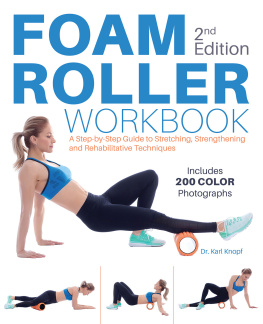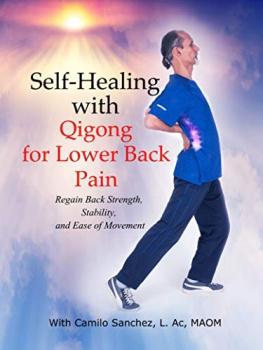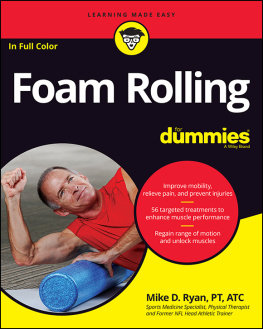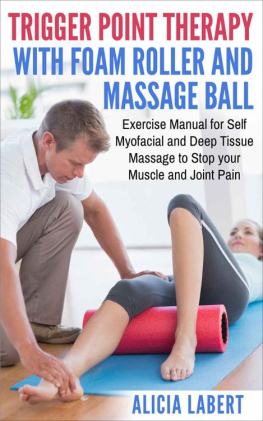
| FOAM | 2nd
Edition |
| ROLLER |
| WORKBOOK |
| Step-by-Step Guide to Stretching, Strengthening and Rehabilitative Techniques |
Dr. Karl Knopf

Text Copyright 2011, 2019 Karl Knopf. Design and Concept 2019 Ulysses Press and its licensors. Photographs copyright 2011, 2019 Rapt Productions except as noted below. All rights reserved. No part of this publication may be reproduced, stored in a retrieval system, or transmitted in any form or by any means without the prior written permission of the publisher, nor be otherwise circulated in any form of binding or cover other than that in which it is published and without a similar condition being imposed on the subsequent purchaser.
Published in the United States by Ulysses Press P.O. Box 3440 Berkeley, CA 94703 www.ulyssespress.com ISBN: 978-1-61243-886-3 Acquisitions: Keith Riegert and Kelly Reed Managing editor: Claire Chun Editors: Lily Chou, Shayna Keyles Proofreader: Lauren Harrison Indexer: Sayre Van Young Production: Claire Sielaff Cover design: what!design @ whatweb.com Photographs: Rapt Productions except from Maridav Models: Lily Chou, Maya Craig, Lauren Harrison, Karl Knopf, Christopher Caruthers, Toni Silver, Nadia Velasquez Distributed by Publishers Group West PLEASE NOTE: This book has been written and published strictly for informational purposes, and in no way should be used as a substitute for consultation with health care professionals. You should not consider educational material herein to be the practice of medicine or to replace consultation with a physician or other medical practitioner. The authors and publisher are providing you with information in this work so that you can have the knowledge and can choose, at your own risk, to act on that knowledge. The author and publisher also urge all readers to be aware of their health status and to consult health care professionals before beginning any health program. This book is independently authored and published and no sponsorship or endorsement of this book by, and no affiliation with, any trademarked brands or other products mentioned or pictured within is claimed or suggested.
All trademarks that appear in this book belong to their respective owners and are used here for informational purposes only. The author and publisher encourage readers to patronize the quality brands and other products mentioned and pictured in this book. Contents PART 1Getting StartedIntroduction to Foam Rolling We see many claims about fitness tools but they often dont live up to the hype when reviewed by experts. Numerous claims have been made that foam rolling increases blood flow, is useful in warming up the muscle prior to exercise, and assists in post-exercise recovery. A study reported in the respected Journal of Strength and Conditioning Research determined that foam rolling is worth the effort: Areas massaged with the foam roller saw increased arterial blood flow. The foam roller lives up to the claims; it is a useful tool that should be part of your exercise tool belt.
Foam rollers were once used exclusively in a physical therapy setting. Dr. Mosh Feldenkrais is credited with being the first person to use rollers for therapeutic purposes (for instance, improving body alignment, reducing muscle tightness, teaching body awareness) in the late 1950s. Foam rollers have been used by a variety of clients with conditions ranging from multiple sclerosis to common orthopedic concerns. The beauty of the foam roller is that it can be used by almost everyone.
Research has shown that stretching, relaxation, meditation, foam rolling, and biofeedback techniques all ease muscle tension, which contributes to pain and common muscle stiffness.
A massage is a favorite method of stretching and relaxing tight muscles. It enhances functional range of motion, aids in the healing process, decreases muscle reflex activity, inhibits motor-neuron excitability, and contributes to relaxation. However, not many people can afford a daily or weekly massage session. A regular foam roller session can provide many of the benefits same benefits as and prolong the benefits of a massage while adding diversity and challenge to your standard exercise program. Designing a balanced exercise routine that includes flexibility movements with strength training, cardiovascular exercise, and relaxation can reduce chronic discomfort and stress. Since foam rollers break up interwoven muscle fibers and help move oxygenated blood into those muscles, theyre an excellent device with which to release tight spots in the muscles (the technical term is myofascial release) and return the muscles to a more optimal state.
This can be done prior to exercising to improve range of motion, after a workout, or during a break at work to relax tight muscles and reduce soreness from sitting too long. Why Use Foam Rollers? While a good massage feels great, the results are often fleeting. For the price of one massage, you can buy a foam roller and get the kinks out daily. The research shows that using a foam roller regularly can improve blood flow and release tension in stiff muscles. (This is not to say that a foam roller session is better than a therapeutic massage; the foam roller is, however, a nice adjunct to a massage.) The human body is designed in a remarkable manner and, if well maintained, will function efficiently for a very long time. Unfortunately, all too often we misuse or abuse our bodies, perhaps through activities of daily living or overuse.
Whether youre highly active or sedentary, we all can benefit from a few minutes of light stretching and relaxation every day. A gentle, daily dose of movement keeps the joints lubricated and limbermotion is lotion. More and more research in the field of exercise science shows that many of our chronic health issues can be positively influenced with corrective exercise. A former chief of orthopedics at Stanford Universitys School of Medicine once told me, Modern medicine can do remarkable things, but we are nowhere close to rebuilding the human machine as well as the original equipment we were born with. In todays world of hustle and bustle, we all need practical ways to recover from the stresses of work and play. No one doubts the restorative benefits of sleep, but other options exist as well, such as massage and compression garments, which help improve circulation.
But right along with these options is self-myofascial release (SMR), which can be done with a foam roller. SMR is becoming a cost-effective method for enhancing mobility, flexibility, and post-exercise recovery. Some sports science experts suggest that it is an effective method for improving range of motion in athletes without interfering with performance. It is believed that the improved circulation afforded by SMR assists with removing metabolic byproducts, such as lactate accumulation. Another benefit of the foam roller is that it is a nice method for re-setting your posture. Advantages of Foam Rolling The basic premise of foam rolling is that it loosens the fascia, a type of connective tissue, which can become trapped and lead to hypersensitive trigger points along the muscle and connective tissue. Advantages of Foam Rolling The basic premise of foam rolling is that it loosens the fascia, a type of connective tissue, which can become trapped and lead to hypersensitive trigger points along the muscle and connective tissue.
Next page









 Text Copyright 2011, 2019 Karl Knopf. Design and Concept 2019 Ulysses Press and its licensors. Photographs copyright 2011, 2019 Rapt Productions except as noted below. All rights reserved. No part of this publication may be reproduced, stored in a retrieval system, or transmitted in any form or by any means without the prior written permission of the publisher, nor be otherwise circulated in any form of binding or cover other than that in which it is published and without a similar condition being imposed on the subsequent purchaser.
Text Copyright 2011, 2019 Karl Knopf. Design and Concept 2019 Ulysses Press and its licensors. Photographs copyright 2011, 2019 Rapt Productions except as noted below. All rights reserved. No part of this publication may be reproduced, stored in a retrieval system, or transmitted in any form or by any means without the prior written permission of the publisher, nor be otherwise circulated in any form of binding or cover other than that in which it is published and without a similar condition being imposed on the subsequent purchaser. 